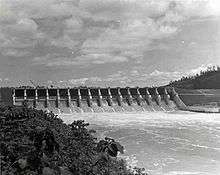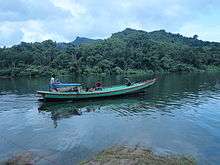Kaptai Dam
| Kaptai Dam | |
|---|---|
 Location of Kaptai Dam in Bangladesh | |
| Country | Bangladesh |
| Location | Kaptai, Rangamati District |
| Coordinates | 22°29′40.11″N 92°13′31.53″E / 22.4944750°N 92.2254250°ECoordinates: 22°29′40.11″N 92°13′31.53″E / 22.4944750°N 92.2254250°E |
| Purpose | Power |
| Status | Operational |
| Construction began | 1957 |
| Opening date | 1962 |
| Dam and spillways | |
| Type of dam | Embankment |
| Impounds | Karnaphuli River |
| Height | 45.7 m (150 ft) |
| Length | 670.6 m (2,200 ft) |
| Width (crest) | 7.6 m (25 ft) |
| Width (base) | 45.7 m (150 ft) |
| Dam volume | 1,977,000 m3 (69,800,000 cu ft) |
| Spillway type | Controlled, 16 gates |
| Spillway capacity | 16,000 m3/s (570,000 cu ft/s) |
| Reservoir | |
| Creates | Kaptai Lake |
| Total capacity | 6,477,000,000 m3 (5,251,000 acre·ft) |
| Catchment area | 11,000 km2 (4,200 sq mi) |
| Surface area | 777 km2 (300 sq mi) |
| Normal elevation | 33 m (108 ft) |
| Power station | |
| Commission date | 1962, 1982, 1988 |
| Turbines | 2 x 40 MW (54,000 hp), 3 x 50 MW (67,000 hp) Kaplan-type |
| Installed capacity | 230 MW (310,000 hp) |
Kaptai Dam (Bengali: কাপ্তাই বাঁধ) is on the Karnaphuli River at Kaptai, 65 kilometres (40 mi) upstream from Chittagong in Rangamati District, Bangladesh. It is an earth-fill embankment dam with a reservoir (known as Kaptai Lake) water storage capacity of 6,477 million cubic metres (5,251,000 acre·ft). The primary purpose of the dam and reservoir was to generate hydroelectric power. Construction was completed in 1962. The generators in the 230 megawatts (310,000 hp) Karnafuli Hydroelectric Power Station were commissioned between 1962 and 1988.[1] It is the only hydroelectric power station in Bangladesh.[2]
History

A brief reconnaissance occurred in 1906 when the Karnafuli Hydropower Station was first contemplated. A second study was carried out in 1923. In 1946, E. A. Moore recommended the proposed project at Barkal about 65 kilometers upstream of present dam site at Kaptai. In 1950, the Marz Rendal Vatten Consulting Engineers suggested a site at Chilardak, about 45 kilometers upstream of Kaptai.
In 1951, the government engineers proposed Chitmoram, 11 kilometres (6.8 mi) downstream of the present site. Under the guidance of then chief engineer (Irrigation) Khwaja Azimuddin, the construction site was chosen in 1951. Utah International Inc. was selected as construction contractor. Construction of the dam started in 1957.
Construction
Starting in 1957, the initial phase of the construction was completed in 1962. By this time the dam, spillway, penstock and two 40 MW Kaplan turbine generators were built in the power station. In August 1982 a 50 MW generator was commissioned. In October 1988 the fourth and fifth generating units, both 50 MW Kaplan-type turbines, were installed which raised the total generation capacity to 230 MW.[3]
The total cost of Unit 1, Unit 2 and a part of Unit 3 was Rs. 503 million and the total cost of extension was Tk. 1,900 million. The project was financed by the East Pakistan Government (at the time), United States and the Overseas Economic Cooperation Fund.[3][1]
Description

The earthen dam is 670 metres (2,200 ft) long and 45.7 metres (150 ft) wide with a 16-gate spillway on the left side.[1] The construction of the dam submerged 655 square kilometres (253 sq mi) area. This included 220 square kilometres (85 sq mi) of cultivable land, 40 percent of the cultivable land in the area, and displaced 18,000 families and 100,000 tribal people, of which 70% were Chakma. The dam flooded the original Rangamati town and other structures.[4]
Social and ecological effects
Inhabitants of the storage reservoir area who lost their homes and farmland due to flooding were not compensated. More than 40,000 Chakma tribals emigrated to India. The scarcity of land is considered a main cause of the continuing conflict in the area.[4]
The building of the dam and reservoir also caused destruction of wilderness and loss of wildlife and wildlife habitats.[1]
Notes
- 1 2 3 4 Bari, M Fazlul (2012). "Dam". In Islam, Sirajul; Jamal, Ahmed A. Banglapedia: National Encyclopedia of Bangladesh (Second ed.). Asiatic Society of Bangladesh.
- ↑ Saila Parveen, I. M. Faisal (21 July 2010). "People versus Power: The Geopolitics of Kaptai Dam in Bangladesh". International Journal of Water Resources Development. doi:10.1080/07900620220121756. Retrieved 10 January 2015.
- 1 2 "Power Plants" (PDF). Bangladesh Power Development Board. March 2010. Retrieved 15 March 2013.
- 1 2 "The construction of the Kaptai dam uproots the indigenous population (1957-1963)". Retrieved 2007-02-01.
External links
| Wikimedia Commons has media related to Kaptai. |
- Dams Caused Environmental Refugees of Ethnic Minorities
- Profile
- Embankment Dams
- Jum Cultivation and Environmental Degradation in CHT